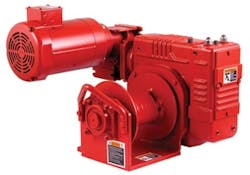Leak Detection System Has Successful Pilot in Nation's Capital
By Dean Slejko
Aging water infrastructure is a well-known and documented problem. In recent years, there have been numerous reports documenting spectacular main failures resulting in massive, dangerous, and expensive leaks. Motorists stranded by a main break in Maryland a few years ago had to be evacuated from a road, while a mayor in Michigan declared a state of emergency after a record 107 main breaks in one winter. More recently, a main break in Texas resulted in loss of over a million gallons of water.
Like many municipal water companies, the District of Columbia Water and Sewer Authority (DC Water), which services the 600,000 residents and 16.6 million annual visitors to the nation's capital, must deal with the problem of aging infrastructure. Over 300 of DC Water's 1300 miles of water mains are over 100 years old, with the average age of underground pipes being 77 years.
"We're averaging a leak a day, and more in the winter months," said Curt Cochrane, DC Water's water operations manager. That adds up to about 500 water main leaks a year.
As the mains get older, the number of leaks in the system is increasing. Joint leaks are a major cause of water revenue loss on older mains. Washington's joint leaks are difficult to find because many of the city's water mains are located under streets that are surrounded by other underground utilities. In this environment, a leak does not easily find its way to the surface. It may follow along the pipe underground until it reaches a sanitary sewer, electrical vault, or some other point of easy escape. A couple of gallons per minute can be lost through this type of leak, which may amount to 3,000 to 5,000 gallons a day.
The bottom line is that leaks add up. According to Cochrane, up to 20 percent of the water pumped into DC Water's distribution system never makes it to customers' meters. This unaccounted for water can be attributed to a number of factors but unidentified leaks represent a significant portion of unaccounted for water.
Proactive Leak Detection
To get control of the problem of underground leaks, DC Water appropriated funding to conduct a leak detection pilot project. Five vendor solutions were initially considered and two were selected for a field trial to test their effectiveness in identifying probable leak locations. An area comprising four city blocks with suspected leaks was identified for the pilot project.
Both solutions used acoustic sensing devices to monitor and analyze noise characteristics in the pipe network. One solution placed the devices on service lines from the main to the home with drive-by data collection once per week. The other, the Star® ZoneScan leak-detection system from Aclara, placed the acoustic devices on valves along the main and used the fixed network Star Network AMI system for daily data collection.
The ZoneScan system deploys acoustic loggers from Gutermann International, a Swiss company specializing in leak detection, on valves at regular intervals throughout the water pipeline network. The leak-intelligence units monitor and analyze noise characteristics in the pipe network. Daily recordings are initiated by time-synchronized signals from the network AMI system so that cross-correlations can be performed between adjacent loggers.
The packaging for Aclara's integrated system includes a meter transmission unit (MTU) mounted within a non-metallic cover that is connected to a Gutermann logger by a watertight cable. The MTUs are deployed on 2-to-20-in. diameter distribution mains, with the logger connecting magnetically to the valve stem. Once deployed, the system detects leak noise every night, no matter what the decibel level. Data from the loggers is sent to the utility automatically via the AMI system to the Aclara Network Control Computer and to the Gutermann web-based ZoneScan Net software. The software performs cross-correlations between adjacent loggers using pipe diameter, material, and distance between loggers to pinpoint leak locations.
DC Water Results
In the pilot program, the ZoneScan system successfully found one leak that was subsequently verified and repaired, and has subsequently pinpointed the location of another probable leak in the same area. The system was better at picking up leak noise than other methods, according to Cochrane, noting that the devices on the service lines in the same area did not detect the leak.
Once DC Water had data related to the probable leak location, it sent a crew to the field to verify the leak location.
"The Aclara system did a fine job telling us where the leak was," said Cochrane.
DC Water plans to incorporate ZoneScan into their existing Star Network AMI. It will place loggers in areas where the utility suspects there may be leaks, and once leaks are identified and repaired move them to the next trouble spot.
According to Linn McClelland, DC Water's manager of IT Enterprise Applications, which includes the AMI system, this flexible approach will "allow us to intelligently and proactively address our network infrastructure while taking advantage of our existing fixed network AMI system."
Aclara's system has definite advantages for DC Water over other leak-detection solutions. First and foremost, data collection from the loggers was done automatically avoiding the time and expense of drive-by data collection. The other primary advantage is that the ZoneScan solution also automatically performs cross-correlations between adjacent loggers, with graphical results showing probable leak locations viewed from the utility office.
"Since the probable leak locations are visually identified, we can look at it each morning and know where to send our crews," said Cochrane.
About the Author: Dean Slejko is Product Manager for Aclara. For more information on the Star ZoneScan system, visit http://bit.ly/STARZoneScan
More WaterWorld Current Issue Articles
More WaterWorld Archives Issue Articles


